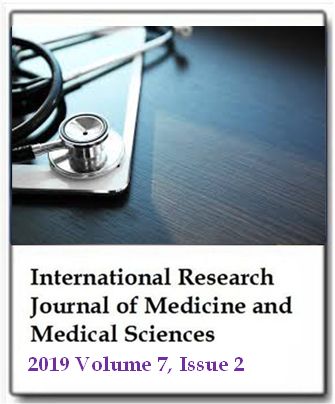Placenta praevia with or without antepartum bleeding in a Nigerian suburban tertiary health institution
Olugbenga EO, Eifediyi RA, Olugbenga MA, Ikheloa J, Okoeguale J, Omoregbee HI and Oboh SAInternational Research Journal of Medicine and Medical Sciences
Published: June 13 2019
Volume 7, Issue 2
Pages 53-59
DOl: https://doi.org/10.30918/IRJMMS.72.19.024
Abstract
Placenta praevia is an abnormal implantation of the placenta in the lower uterine segment and it is a significant contributor to obstetric haemorrhage worldwide. This study was done to review the presentation, management modalities as well as obstetric outcome of placenta praevia with or without vaginal bleeding. This was a retrospective analysis of 125 cases of placenta praevia between 1st January, 2011 and 31st December, 2015. Information retrieved from case notes include the age, booking status, parity, level of education, gestational age at diagnosis, gestational age at delivery, symptoms at presentation, diagnosis, mode of delivery, past reproductive performance, blood transfusion as well as fetal and maternal outcomes. There were 8,735 deliveries in the period under review of which 125 patients had placenta praevia. This gave a prevalence of 1.4% or 14 cases per 1,000 deliveries. The mean age of occurrence was 30.9 ± 2.107 years. Majority of the patients were primipara with previous uterine surgeries (uterine evacuation, Caesarean section or myomectomy) and presenting mainly in unbooked patients (67.2%). Diagnosis was made at term in 38.4% of the patients and 60.8% of the patients had warning bleeding or incidental ultrasound finding of placenta praevia before term. The commonest type of placenta praevia was type III (48.8%) while the least common was type I (7.2%). The delivery was by Caesarean section in 98.4% of the patients with 71.2% having emergency Caesarean section. Out of a total of 130 babies born to these patients, 109 (83.8%) were live births. Seventy-seven women (61.6%) of the studied population had blood transfusion out of which 60 (78%) had at least 2 pints of blood transfused. There was no maternal mortality. In conclusion, the no maternal mortality recorded in this study could be attributed to the presence of highly skilled birth attendants, prompt surgical intervention and readily availability of blood transfusion services. Attendance of antenatal clinic and third trimester ultrasonography will reduce high rate of emergency delivery and better survival of babies.
Keywords: Placenta praevia, haemorrhage, blood transfusion and outcome.
Full Text PDFThis article is published under the terms of the Creative Commons Attribution License 4.0

